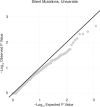Obesity-dependent selection of driver mutations in cancer
- PMID: 39468367
- PMCID: PMC11549034
- DOI: 10.1038/s41588-024-01969-3
Obesity-dependent selection of driver mutations in cancer
Abstract
Obesity is a risk factor for cancer, but whether obesity is linked to specific genomic subtypes of cancer is unknown. We examined the relationship between obesity and tumor genotype in two clinicogenomic corpora. Obesity was associated with specific driver mutations in lung adenocarcinoma, endometrial carcinoma and cancers of unknown primaries, independent of clinical covariates, demographic factors and genetic ancestry. Obesity is therefore a driver of etiological heterogeneity in some cancers.
© 2024. The Author(s).
Conflict of interest statement
The authors declare no competing interests.
Figures



Update of
-
Obesity shapes selection for driver mutations in cancer.medRxiv [Preprint]. 2024 Jan 11:2024.01.10.24301114. doi: 10.1101/2024.01.10.24301114. medRxiv. 2024. Update in: Nat Genet. 2024 Nov;56(11):2318-2321. doi: 10.1038/s41588-024-01969-3. PMID: 38260500 Free PMC article. Updated. Preprint.
References
MeSH terms
Grants and funding
LinkOut - more resources
Full Text Sources
Medical

